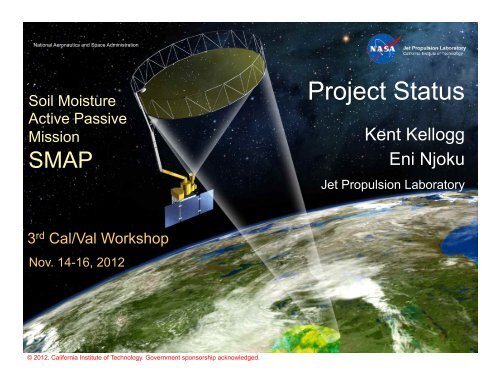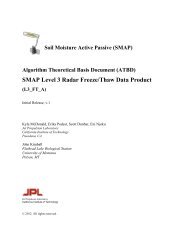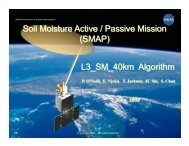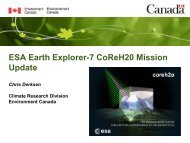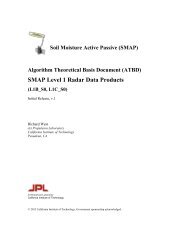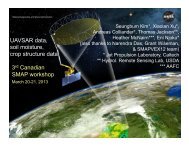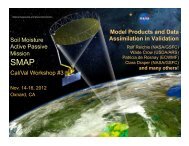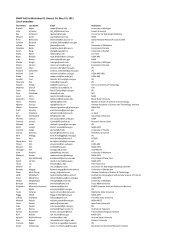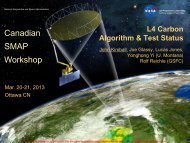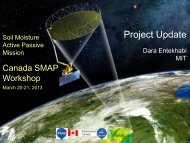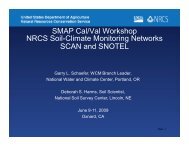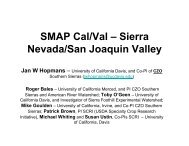2. SMAP Project Status (Eni Njoku, JPL) - NASA
2. SMAP Project Status (Eni Njoku, JPL) - NASA
2. SMAP Project Status (Eni Njoku, JPL) - NASA
Create successful ePaper yourself
Turn your PDF publications into a flip-book with our unique Google optimized e-Paper software.
National Aeronautics and Space AdministrationSoil MoistureActive PassiveMission<strong>SMAP</strong><strong>Project</strong> <strong>Status</strong>Kent Kellogg<strong>Eni</strong> <strong>Njoku</strong>Jet Propulsion Laboratory3 rd Cal/Val WorkshopNov. 14-16, 2012© 201<strong>2.</strong> California Institute of Technology. Government sponsorship acknowledged.
Countdown to Launch Has Started!Launch Readiness Date: October 31, 20141.96 Years23.5 Months716 DaysFromToday!
<strong>SMAP</strong> <strong>Project</strong> OverviewPrimary Science Objectives• Global, high-resolution mapping of soil moisture and itsfreeze/thaw state to: Link terrestrial water, energy, and carbon-cycle processes Estimate global water and energy fluxes at the land surface Quantify net carbon flux in boreal landscapes Extend weather and climate forecast skill Develop improved flood and drought prediction capabilityhttp://smap.jpl.nasa.gov/Mission ImplementationPartnersRiskLaunchOrbitDurationPayload• <strong>JPL</strong> (project & payload management, science, spacecraft, radar,mission operations, science processing)• GSFC (science, radiometer, science processing)• 7120-81 Category 2; 8705.4 Payload Risk Class C• Oct. 2014 on Delta II system• Polar Sun-synchronous; 685 km altitude• 3 years• L-band SAR (<strong>JPL</strong>)• L-band radiometer (GSFC)• Shared 6-m rotating (13 to 14.6 rpm) antenna (<strong>JPL</strong>)NRC Earth Science Decadal Survey (2007)recommended <strong>SMAP</strong> as a tier-one mission
<strong>SMAP</strong> Mission OverviewInstrument• L-band (1.3-GHz) Radar (<strong>JPL</strong>)• L-band (1.4-GHz) Radiometer (GSFC)• Shared antenna (6 m diameter)• Conical scan: 13–14.6 rpm; 40° incidence• Contiguous 1,000-km swath widthMissionDesign<strong>SMAP</strong>Flight System(Observatory)Spacecraft (& Radar Electronics)• <strong>JPL</strong>-Developed & Built• <strong>JPL</strong>’s MSAP/MSL Avionics, Power Assyswith a small number of new missionunique card designs• 1100 kg wet mass (Observatory-level)• 1200 W capacity (Observatory-level)• 80 kg propellant capacity• Commercial space electronics elsewhereSurface Validation• 685-km polar orbit (Sun-sync)• 8-day repeat ground track• Continuous instrument operation• 2- to 3-day global coverage• 3-year mission durationXX XXDelta IINear-Earth NetworkScience Data ProductsSoil Moisture & Freeze/Thaw State Data ProductsAlaska SatelliteFacilityData Center(RadarL1 Products)• <strong>SMAP</strong> is compatible with a number oflaunch vehicles; Delta-II selected in July ‘12• Target Launch: October 31, 2014<strong>SMAP</strong> Mission Operations& Data Processing(<strong>JPL</strong>, GSFC)NationalSnow and IceData Center(all other Products)
Delta II 7320-10C<strong>SMAP</strong> Has A Shiny New Delta II!
<strong>SMAP</strong> <strong>Project</strong>/Science Key Review <strong>Status</strong>• <strong>Project</strong> was successfully confirmed (KDP-C, May 23, 2012) and isnow in phase C/D• <strong>Project</strong> held successful combined <strong>Project</strong>/Flight System/InstrumentCDR on July 16-19, 2012• Mission System and Science held successful Cal/Val Peer Review onOctober 2, 2012• Mission System held successful Science Data System (SDS) CDR onOctober 10-11, 2012• <strong>Project</strong> held successful Mission System CDR on November 8, 2012• Next big <strong>NASA</strong> gate: System Integration Review (April 9-12,2013)
Instrument OverviewRADIOMETER BRIGHTNESSTEMPERATURE PRODUCT (40KM)L-band (1.41 GHz)Radiometer for highsoil moisture accuracyat moderate spatialresolutionL-band (1.26 GHz)Radar: UnfocusedSynthetic Aperture forhigh spatial resolution &freeze/thaw detectionHI-RES RADAR BACKSCATTERPRODUCT (1-3 KM)Radiometer isspun-side-mountedto reduce lossesMass: 357 kgPower: 448WRadar is fixed-mountedto reduce spun inertiaRadiometer– Provided by GSFC– Leverages Aquarius design– Includes RFI mitigation– V, H, 3 rd & 4 th stokes– 1.3-K accuracy– 40-km resolutionCommon 6-m Spinning Reflector– Spin Assembly and Reflector/Boom Assemblyderived from heritage designs– Conically scanning at 13–14.6 rpm– Constant incidence angle of 40-degRadar– Provided by <strong>JPL</strong>– Leverages <strong>JPL</strong> designs– Includes RFI mitigation– Polarizations: VV, HH, HV– 500-W SSPA (9% duty cycle)– 3-km spatial resolution
Mission Systems OverviewS BandX BandNear Earth NetworkTelemetryVisibilityfor CriticalEventsTDRSS• <strong>SMAP</strong> would use <strong>JPL</strong>’s Earth Science Multi-Mission Facility• NEN used for routine science data and T&C– NEN upgrades to support DS missions are being put inplace for <strong>SMAP</strong> (will be completed within next year)• TDRSS used for critical events telemetryvisibility and commanding if necessary• EDOS provides L0 processing & routing• <strong>JPL</strong> performs L1-3 processing• GSFC/GMAO performs L4 processing• Data Centers: NSIDC and ASFGSFC CommCloud & EDOS<strong>JPL</strong> <strong>SMAP</strong>MOS Facility<strong>JPL</strong> <strong>SMAP</strong> SDSFacility(L1-L3 products)GSFCGMAO(L4 products)Data Centers:ASF (Radar L1)NSIDC (Other)Science Community &Applications Users
Observatory ConfigurationHas Been Stable• 3-axis-stabilized spacecraft, providesmomentum compensation for RBA• Single-string avionics and power control/distribution electronicsRadiometerFront EndAntennaFeed HornReflector BoomAssembly (RBA)Instrument ControlElectronics (ICE)• Redundant S-band telecom (NEN & TDRS)and 130 Mbps X-band link for science data• Limited redundancy in ACS sensorsand actuators• 3 panel deployable, fixed solar array• Hydrazine blowdown propulsion system• Passive and heater-based thermal control withbus structure serving as radiatorsSpun PlatformAssemblyDeployedSolar ArrayStarTrackerBatteryLV AdapterRadarMagnetometerS- & X-band LGAs• 1089 kg wet mass• 1023 W (science mode load), via3-panel deployable solar array• 59-Ah BOL battery for launch, eclipse, andother off-Sun modes• 80.0 kg usable propellant capacity• Delta-V: 11<strong>2.</strong>6 m/s (includes contingency)
Flight Power Subsystem Electronics areBuilt and are in Assembly and TestFlight Spacecraft Power Bus Controller SliceFlight Power Subsystem “Three Slice Box” Assembly is in TestRemote Engineering, H/K Power Conversion, Guidance I/F DriverPyro Firing Slices are Assembled and TestedFlight Solar Array Interface & Switching Slice
Flight Spacecraft Bus MechanicalPanels & Decks are in ManufacturingSpacecraft Zenith Panel (Instrument Deck)in rough machiningSpacecraft Propulsion Deck in rough machiningSpacecraft -Y Panel (Radar Panel)in rough machining
Flight Telecom Antennas (S- & X-band)Delivered to <strong>JPL</strong>Telecom AntennaCognizant EngineerLuis Amaro with RUAGS- and X-band TelecomAntennas in theirShipping Container
EM Radiometer Testing is Complete FlightRadiometer Hardware in Production & TestEM Radiometer Digital Electronics Assy (RDE)EM Radiometer RF Electronics Assembly (RRE)Flight Analog Processing Board #1 in TestFlight Correlated Noise Source
All Radar Flight Hardware ManufacturingIs Complete; Assembly & Test is UnderwayRadar Flight Digital Electronics Assembly in TestRadar RF Assembly in Vibration TestFlight Calibration Loops have been deliveredFlight High Power Switchhas been deliveredHigh Power Amplifier is in Assembly
Spin Subsystem Launch LockQualification & Development AssemblyLower InstrumentCore StructureSegmentCone-ClutchAssembly(Launch Lockfor Spin S/S)Brassboard Bearing & PowerTransfer Assembly (BAPTA)Integrated Development Cone-Clutch Assy (CCA)and Lower Core Instrument Structure SegmentCCA/BAPTA in randomvibration test configurationIntegrated Brassboard CCA and BAPTACCA (bottom view showing inner cone)
Antenna Scale Model Testing Completed,Data Reduction & Analysis Underway<strong>SMAP</strong> Scale Model Observatory (10.45 to 1 scale)13.137 GHz scaled radar frequency14.771 GHz scaled radiometer frequency<strong>SMAP</strong> Scale Model Observatory being Tested in <strong>JPL</strong>’sCylindrical Near Field Range (Mesa 40’ chamber)
Flight Reflector Mesh is Being Assembled(NGST Astro Aerospace)
Science Schedule and Milestones<strong>SMAP</strong> <strong>Project</strong> Phases<strong>SMAP</strong> Science Top Level ScheduleRev. 10/10/20122011 2012 2013 2014 2015 2016 2017 2018Q2 Q3 Q4 Q1 Q2 Q3 Q4 Q1 Q2 Q3 Q4 Q1 Q2 Q3 Q4 Q1 Q2 Q3 Q4 Q1 Q2 Q3 Q4 Q1 Q2 Q3 Q4 Q1 Q2 Q3Phase BPhase C/DPhase E<strong>Project</strong> Mgmt MilestonesScience MeetingsMS PDRPDR 11/1410/10CDR MS CDR7/1611/6SIR Start ATLO4/38/2Start ORT ORRLaunch4/30 8/20 10/31SDT SDT<strong>SMAP</strong>/ICETutorial#7 #8 Workshop SDT #10 ST #1 ST #2 ST #3 ST #4 ST #5App8/18 10/3Workshop #28/19 11/9 3/20 SDT #9 3/1910/229/1 Select ST<strong>SMAP</strong>/GRACE/GPMApp Workshop #4 8/12Tutorial Workshop10/17App Workshop #5ST #6Level 2-3 Science AlgorithmsDel 2to SDS2/29Del 3to SDS InitialATBDAlgorithmDel 4 Selection Del 5to SDS Review to SDS5/238/291/27Deliver ValidatedSoftware to SDS11/29Deliver End of MissionSoftware to SDS11/293/2Level 4 Science AlgorithmsDel 3to Proj8/16InitialATBDDel 4to Proj8/12Del 5to Proj1/10Deliver ValidatedSoftware to SDS11/29Deliver End of MissionSoftware to SDS11/293/2Cal/Val<strong>SMAP</strong>VEX 12Science OperationsStart Procurement2/8Cal/ValReview10/2CalValWorkshop #311/14FlightsCompleteI&T 7/19CompCloseoutStart EndCalVal CalValRehearsal Rehearsal6/19/1CalValWorkshop #411/15CalValWorkshop #5LaunchPrepare Startfor CalVal CalVal10/3010/30End L1CalVal2/10<strong>SMAP</strong>VEX 15CalValWorkshop #6L1 User Guideand ATBD'sL1 Data Releaseto Data CenterEnd L2/4CalValCalValWorkshop #7CalValWorkshop #8L2/4 Data Releaseto Data CenterL2/4 User Guideand ATBD'sCalValWorkshop #9End Cal/ValMonitoring3/2End ofMission3/2Milestone Review Completed Review Completed Milestone
Science Key Reviews/Meetings• SDT meetings: #9, Oct. 3-4, 2012, #10, March 5-7, 2013• SDT transition to augmented Science Team: Sept/Oct 2013• Algorithm Baseline Selection Review: September 2013• Cal/Val Peer Review: Oct. 2, 2012• Cal/Val Rehearsals:– June-September 2013: Initial test of core site/sparse network datacollection– Spring 2014: Expanded rehearsal based on lessons learned andupdated tools• <strong>SMAP</strong> Cal/Val Workshops:– #3 Nov. 14-16, 2012 (plan 2013 rehearsal)– #4 November 2013 (review rehearsal 1; plan rehearsal 2)– #5 July/August 2014 (~launch-3mths; review rehearsal 2, and launchprep)– #6 Feb/Mar 2015 (~first data & Cal/Val assessments)
Algorithm & Documentation <strong>Status</strong>• Algorithm Software Delivery 3 to SDS is complete• ATBD status– Initial release (v.1): October 2012 (updates, v.1.1 …) – posted on <strong>SMAP</strong> website– Final pre-launch version (v.2): September 2014• Data Product Specifications– Passive L2/3 products: November 2012 prelim– Active & active/passive L2/3 products: January 2013 prelim– Final dates: ~Oct. 2013• Science Cal/Val Plans– Science Data Cal/Val Plan: init. release July 2012 (at CDR)– <strong>Project</strong> L1 Cal/Val Plan: draft in progress (~Nov 2012)– <strong>Project</strong> L2-L4 Cal/Val Plan: draft complete (~Oct 2012)• Data Product Users Guide(s)– Prepared in collaboration with DAACs
SDT Transition to Science Team• ROSES <strong>SMAP</strong> Science Team solicitation issued by <strong>NASA</strong>/HQ onFebruary 14, 2012“A.24 The Soil Moisture Active Passive Mission (<strong>SMAP</strong>) Science Team”– Science Team (ST) is expected to consist of up to 15 U.S. members (plusnon-U.S. team members)– Expected annual program budget for new awards ~ $1600K+(?)– Maximum duration of awards expected to be through mission life(?)– NOI due date: (see pending ROSES amendment update)– Proposals due date: 02/01/2013– Selections: 07/31/2013– ST contracts in place: 09/30/2013• See <strong>SMAP</strong> web page for further detailshttp://smap.jpl.nasa.gov/science/team/STInfo/
<strong>SMAP</strong> Science Team• Science Team members will:– Provide guidance to the <strong>SMAP</strong> <strong>Project</strong> in implementation of the Cal/Val Planfor the mission;– Participate directly in carrying out Cal/Val activities specified in the Cal/ValPlan; Expect to attend several meetings and telecons during first 12 months– Through implementation of the Cal/Val Plan, assess the accuracies of theinstrument data products (Level 1) and geophysical data products (Level 2-Level 4) generated by the mission and the performance of the algorithmsused to create these products;– Identify necessary actions to be taken by the <strong>Project</strong> in improving the qualityof the data products generated by the mission;– Provide guidance on improvements to the Science Data System (SDS)necessary to support the mission data processing; and– Provide guidance for the entrainment of <strong>SMAP</strong> mission data in applicationusers’ models, processes, and decision support systems.
<strong>SMAP</strong> <strong>Project</strong> <strong>Status</strong>END


